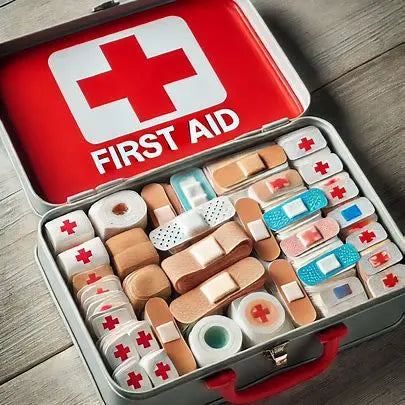
What Bandages Should You Have in Your First Aid Kit?
Share
Cuts, scrapes, and grazes are among the most common injuries, and proper wound care is essential for effective healing. While bandages, dressings, and plasters are all critical tools in first aid, understanding when and how to use each is key to achieving the best results. Here, we’ll explore the differences between these essential wound care items and their appropriate applications.
What Are Bandages?
Bandages are flexible materials used to secure dressings, provide support to injured areas, or apply pressure to control bleeding. Unlike dressings, which are applied directly to the wound, bandages are typically wrapped around the injury site.
Bandages are indispensable for:
- Securing dressings: Keeping them in place to protect the wound.
- Providing compression: Reducing swelling or controlling bleeding.
- Immobilizing injuries: Stabilizing sprains, strains, or fractures.
There are several types of bandages, including elastic, crepe, cohesive, and triangular bandages, each serving specific purposes. Elastic bandages are ideal for compressing injuries, while cohesive bandages are perfect for sensitive areas as they stick to themselves rather than the skin.
Why Use Bandages?
Bandages serve multiple purposes in wound care:
- They protect wounds from dirt and bacteria.
- They control bleeding by applying pressure.
- They support injured joints or muscles.
- They secure dressings in place, especially in areas where adhesives may not work well.
When applying a bandage, ensure it is snug but not too tight to avoid restricting blood flow.
Dressings: Essential for Wound Healing
Dressings are materials placed directly on wounds to aid in healing and prevent infection. Unlike bandages, dressings have therapeutic properties, such as absorbing exudate and maintaining a moist environment conducive to healing.
Common Types of Dressings:
- Gauze Dressings: Absorbent and breathable, suitable for a wide range of wounds.
- Non-Adherent Pads: Prevent sticking to the wound, ideal for burns or surgical sites.
- Hydrocolloid Dressings: Provide a moist environment and promote faster healing.
- Transparent Films: Allow monitoring of the wound without removal.
Dressings should be changed regularly based on the wound’s condition. Always clean the wound thoroughly before applying a new dressing.
Plasters: Convenient for Minor Injuries
Plasters, also known as adhesive bandages, are small, self-contained wound care solutions. They consist of an absorbent pad surrounded by adhesive material, making them perfect for minor cuts, scrapes, and blisters.
Benefits of Plasters:
- Easy to use and apply.
- Protect wounds from dirt and bacteria.
- Provide cushioning to prevent irritation.
Plasters are best suited for small injuries that do not require extensive wound care. They come in various sizes and shapes to accommodate different wound locations. For flexible and durable options, consider using Band-Aid Flexible Fabric Adhesive Bandages.
Bandages, Dressings, and Plasters: Understanding the Differences
While bandages, dressings, and plasters all serve the purpose of wound care, their uses vary:
- Bandages: Secure dressings, provide support, or apply pressure.
- Dressings: Promote healing by protecting and hydrating wounds.
- Plasters: Cover minor injuries for basic protection.
Choosing the right option depends on the wound’s size, location, and severity.
Proper Wound Care Techniques
Effective wound care involves more than just choosing the right product. Follow these steps for optimal healing:
- Clean the Wound: Use clean water and antiseptic to wash away debris and bacteria.
- Apply the Right Dressing: Choose a dressing based on the wound type and severity.
- Secure with a Bandage or Plaster: Use a bandage for larger injuries or a plaster for small wounds.
- Monitor for Infection: Watch for signs like redness, swelling, or pus, and seek medical attention if needed.
Avoid common mistakes such as using expired products, applying bandages too tightly, or neglecting proper hygiene.
Adhesive Bandages
Adhesive bandages, commonly referred to as plasters or Band-Aids®, are versatile and practical for everyday injuries. They are particularly effective for wounds on hands, knees, and elbows, where movement may dislodge other types of dressings.
Our Band-Aid Flexible Fabric Adhesive Bandages offer flexibility and comfort, making them ideal for active individuals.
Explore Our Product
When it comes to reliable wound care, Band-Aid Flexible Fabric Adhesive Bandages are a must-have in every first aid kit. Their flexibility, durability, and comfortable fit make them perfect for protecting wounds and promoting healing.
Conclusion
Bandages, dressings, and plasters each play a vital role in wound care. By understanding their differences and proper uses, you can ensure effective healing and minimize the risk of infection. For minor injuries, adhesive bandages provide quick and reliable protection. For more extensive wound care needs, dressings and bandages are indispensable.
Invest in high-quality wound care products to stay prepared for any injury. Visit our website to explore the best options for your first aid kit.
Common FAQs
-
What are bandages?
Bandages are flexible materials used to secure dressings, apply pressure, or provide support to injured areas. -
What are the 4 main types of bandages?
Elastic, crepe, cohesive, and triangular bandages are the main types, each suited for specific purposes. -
Why is the bandage used?
Bandages help in protecting wounds, controlling bleeding, and stabilizing injured areas. -
Is a plaster an adhesive bandage?
Yes, plasters are a type of adhesive bandage designed for minor wounds. -
What are the disadvantages of adhesive bandages?
They may not stick well to sweaty or wet skin and can cause irritation on sensitive skin. -
How long does an adhesive bandage last?
Adhesive bandages should be replaced daily or whenever they become wet or dirty.
Fabric bandages offer more flexibility and are better suited for areas of movement, while adhesive bandages work well on flat, dry surfaces.
